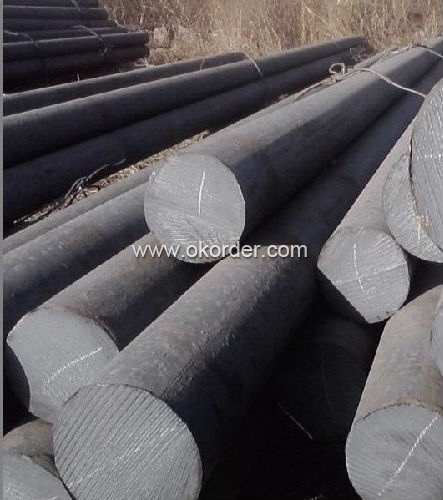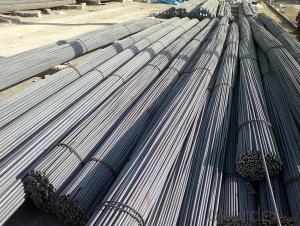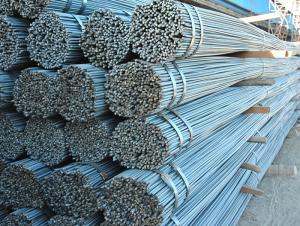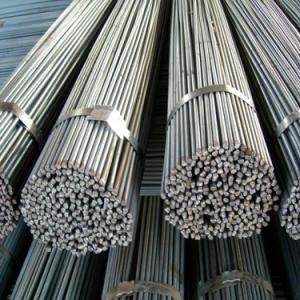Hot Rolled Steel Round Bar 6mm-150mm
- Loading Port:
- Tianjin
- Payment Terms:
- TT OR LC
- Min Order Qty:
- -
- Supply Capability:
- 100000 m.t./month
OKorder Service Pledge
OKorder Financial Service
You Might Also Like
Specifications of Chinese Standard Round Bar
1. Grade: Q195, Q235, Q345
2. Diameter: 6mm-150mm
3. Length: 6m, 9m, 12m or as customer’s request
4. Tolerance: Within ±5% for weight; ±2mm for diameter
5. Note: The price can be better is the quantity is good
6. Chemical composition
Alloy No | Element (%) | ||||
C | Mn | S | P | Si | |
Q195 | 0.06-0.12 | 0.25 | ≤0.05 | ≤0.045 | ≤0.3 |
Q235 | 0.12—0.20 | 0.3—0.7 | ≤0.045 | ≤0.045 | ≤0.3 |
Q345 | ≤0.2 | 1.00-1.60 | ≤0.045 | ≤0.045 | ≤0.55 |
Usage and Applications of Chinese Standard Round Bar
1. Chinese standard steel bar is often used where large amounts of steel need to be formed, for example as structural steel.
2. And we can use this kind of product on the performance of the mechanical parts if the demand is not very high.
3. Steel round bar is used in construction and a large number of architectural and engineering structures.
Packaging & Delivery of Chinese Standard Round Bar
Packaging Detail: All goods are packed in bundle with steel strips and shipped by break bulk vessel or container (depend on target market and different ports)
Delivery Detail: 45 days
Trade terms: FOB, CFR, CIF
MOQ: 25 tons per specification; we can negotiate the quantity if the specification is normal or we have stock of one specification.
Weight: The price invoicing on theoretical weight basis or actual weight basis depends on customer’s request.
Shipment: The shipment of bulk break or container is depends on customer’s request and the situation of the port of destination.
Documents given: Full set of original clean on board bill of lading; Original signed commercial invoice; Original packing list; Policy of insurance; Certificate of origin and what the target market needs.
Production Flow of Chinese Standard Round Bar
1. The common processes are preheated forging quenching, dual refinement solution process, cooling quenching and isothermal quenching. We use heat treatment for dual refinement solution process.
2. Material prepare (billet) — heat up — rough rolling — precision rolling — cooling — packing — storage and transportation
Characteristics of Chinese Standard Round Bar
1. The steel in which the main interstitial alloying constituent is carbon in the range of 0.12–2.0%.
2. As the carbon percentage content rises, steel has the ability to become harder and stronger through heat treating; however it becomes less ductile.
3. Quality should be in conformity with the specification of the manufacturer. Quantity and packing conditions should be in conformity with the term in the contract.
4. Regardless of the heat treatment, higher carbon content reduces weld ability. In carbon steels, the higher carbon content lowers the melting point.

- Q:Can steel round bars be used in the chemical industry?
- Yes, steel round bars can be used in the chemical industry. Steel is often preferred in the chemical industry due to its high strength and durability. Steel round bars are commonly used for construction of storage tanks, pipelines, and equipment in chemical plants. The material's resistance to corrosion makes it suitable for handling various types of chemicals, acids, and alkalis. Steel round bars also provide excellent structural support, which is crucial in maintaining the integrity and safety of chemical processes. Overall, steel round bars are a reliable and widely used material in the chemical industry.
- Q:Can steel round bars be used in the textile industry?
- No, steel round bars are not typically used in the textile industry. Textile manufacturing mainly requires materials such as fibers, yarns, fabrics, and machinery specific to the industry. Steel round bars are more commonly used in construction, engineering, and manufacturing sectors where structural strength is required.
- Q:Will the theoretical weight of thread steel and round steel be the same?
- The rebar is a kind of small section steel, mainly used for the skeleton of reinforced concrete construction members. In use, some mechanical strength, bending deformation property and welding performance are required. The raw steel billet for the production of threaded steel is carbon structural steel or low alloy structural steel which is treated by calm melting, and the finished steel bar is delivered in hot rolling forming, normalizing or hot rolling state.
- Q:How do you prevent rust on steel round bars?
- There are various effective methods available to prevent rust on steel round bars. Here are some strategies you can utilize: 1. Employ a protective coating: An effective way to prevent rust is by applying a protective coating such as paint, varnish, or enamel. These coatings act as a barrier, preventing moisture and oxygen from reaching the steel surface and causing rust. 2. Opt for galvanization: Galvanizing steel round bars involves coating them with a layer of zinc. This process creates a protective barrier, as the zinc acts as a sacrificial anode, corroding instead of the steel. Galvanized steel is highly resistant to rust and is commonly used in outdoor applications. 3. Utilize powder coating: Powder coating is another effective method of preventing rust on steel round bars. In this process, a dry powder is electrostatically applied to the steel surface, which is then cured under heat. The resulting coating provides excellent protection against rust and corrosion. 4. Maintain regular cleaning and maintenance: To prevent rust, it is important to regularly clean your steel round bars and remove any dirt, moisture, or other corrosive substances. Additionally, applying a rust inhibitor or lubricant can further protect the steel from corrosion. 5. Ensure proper storage: Proper storage of steel round bars is crucial in reducing the risk of rust. It is advisable to store them in a dry and well-ventilated area, avoiding direct contact with the ground or moisture-prone areas. Using pallets or racks to keep the steel elevated and properly spaced can also help prevent rust formation. 6. Avoid exposure to harsh environments: Exposing steel round bars to harsh environments, such as saltwater or acidic chemicals, significantly increases the risk of rust. If feasible, it is recommended to protect the steel from prolonged exposure to these substances or consider using a more corrosion-resistant material in such conditions. By implementing these preventive measures, you can effectively minimize the likelihood of rust formation on steel round bars, ensuring their durability and preserving their structural integrity.
- Q:What are the maximum allowable stresses for steel round bars?
- The maximum allowable stresses for steel round bars depend on various factors such as the grade of steel, the specific application, and the safety standards being followed. However, a commonly used value for allowable stress in steel round bars is typically around 60,000 to 70,000 pounds per square inch (psi). It is important to consult the appropriate design codes, standards, or engineering specifications to determine the specific maximum allowable stresses for a given steel round bar.
- Q:What are the applications of steel round bars in the aerospace industry?
- Due to their exceptional strength, durability, and versatility, steel round bars are extensively utilized in the aerospace industry. These bars find application in various areas, including the following: 1. Structural Components: In the production of structural components in the aerospace industry, steel round bars are commonly employed. Aircraft frames, landing gear, wing spars, and other critical structural elements are manufactured using these bars. Steel's high tensile strength guarantees the structural integrity and safety of the aircraft. 2. Fasteners: Fasteners such as bolts, screws, and pins are produced using steel round bars. These fasteners play a crucial role in holding different parts of the aircraft together. Steel's strength and resistance to fatigue make it the ideal material for these vital connections. 3. Engine Components: Various engine components are manufactured using steel round bars. Shafts, crankshafts, connecting rods, and turbine blades are among the components that benefit from the use of these bars. These components need to withstand high temperatures, pressure, and mechanical stress, and steel's heat resistance and strength make it suitable for these demanding conditions. 4. Landing Gear: The landing gear of an aircraft experiences immense stress during takeoff, landing, and taxiing. Steel round bars are used in the construction of landing gear components such as axles and struts. The high strength and toughness of steel ensure the landing gear's ability to withstand the forces encountered during landing operations. 5. Tooling and Fixtures: Tooling and fixtures necessary for the production and maintenance of aircraft are manufactured using steel round bars. These tools and fixtures are utilized in various processes, including machining, assembly, and inspection. Steel's hardness and machinability make it the ideal material for these applications. In conclusion, steel round bars have a wide range of applications in the aerospace industry, including structural components, fasteners, engine parts, landing gear, and tooling. The unique combination of strength, durability, and versatility offered by steel is essential in guaranteeing the performance, safety, and reliability of aerospace systems.
- Q:What are the different grades of alloy steel round bars?
- There are several different grades of alloy steel round bars, including but not limited to, 4140, 4340, 8620, and 52100. Each grade offers specific properties and characteristics that make them suitable for different applications and industries.
- Q:Can steel round bars be bent?
- Yes, steel round bars can be bent. The flexibility of steel allows it to be shaped and manipulated into various forms, including bending round bars into desired angles or curves.
- Q:What is the tolerance level for steel round bars?
- The tolerance level for steel round bars can vary depending on several factors such as the grade and diameter of the bar, as well as the specific industry standards and requirements. Generally, the tolerance level for steel round bars is specified in terms of diameter or diameter deviation. For example, in the manufacturing industry, the tolerance level for steel round bars can be specified as a specific diameter range, such as +/- 0.001 inches or +/- 0.02 millimeters. This means that the actual diameter of the bar should be within this specified range to meet the tolerance requirements. Additionally, the tolerance level can also be specified in terms of diameter deviation, which refers to the difference between the actual diameter of the bar and the specified nominal diameter. This deviation is usually expressed as a percentage or a specific measurement, such as +/- 0.5% or +/- 0.010 inches. It is important to note that the tolerance level for steel round bars can be more stringent in certain industries, such as aerospace or automotive, where precision and quality are critical. In these cases, the tolerance requirements may be narrower to ensure the bar meets the specific performance and safety standards. Ultimately, it is essential to consult the relevant industry standards, specifications, or customer requirements to determine the specific tolerance level for steel round bars in a particular application.
- Q:What are the different grades of carbon steel round bars for structural applications?
- Structural applications offer a variety of grades for carbon steel round bars, each possessing unique properties and characteristics. Some commonly used grades are as follows: 1. ASTM A36: Widely utilized for structural projects, this grade of carbon steel round bars boasts exceptional weldability and machinability. 2. ASTM A572-50: This high-strength, low-alloy structural steel grade provides an improved strength-to-weight ratio compared to traditional carbon steel. It is often employed in construction and structural applications requiring high strength. 3. ASTM A588: Primarily utilized in corrosion-resistant applications, this high-strength, low-alloy structural steel grade demonstrates excellent atmospheric corrosion resistance. It finds frequent usage in outdoor structures like bridges and buildings. 4. ASTM A709: Commonly employed in bridge construction, this high-strength, low-alloy structural steel grade offers outstanding strength, weldability, and toughness, making it ideal for demanding structural applications. 5. ASTM A105: This low-carbon steel grade possesses good strength and impact resistance, making it suitable for applications necessitating high strength and ductility, such as heavy equipment and machinery construction. These examples represent a limited selection of carbon steel round bar grades available for structural applications. The selection of an appropriate grade depends on factors including desired strength, weldability, machinability, and corrosion resistance. It is advisable to consult with a steel supplier or engineer to determine the most suitable grade for a specific application.
1. Manufacturer Overview |
|
|---|---|
| Location | |
| Year Established | |
| Annual Output Value | |
| Main Markets | |
| Company Certifications | |
2. Manufacturer Certificates |
|
|---|---|
| a) Certification Name | |
| Range | |
| Reference | |
| Validity Period | |
3. Manufacturer Capability |
|
|---|---|
| a)Trade Capacity | |
| Nearest Port | |
| Export Percentage | |
| No.of Employees in Trade Department | |
| Language Spoken: | |
| b)Factory Information | |
| Factory Size: | |
| No. of Production Lines | |
| Contract Manufacturing | |
| Product Price Range | |
Send your message to us
Hot Rolled Steel Round Bar 6mm-150mm
- Loading Port:
- Tianjin
- Payment Terms:
- TT OR LC
- Min Order Qty:
- -
- Supply Capability:
- 100000 m.t./month
OKorder Service Pledge
OKorder Financial Service
Similar products
New products
Hot products
Hot Searches
Related keywords






























